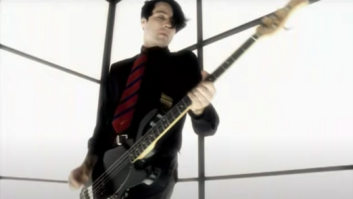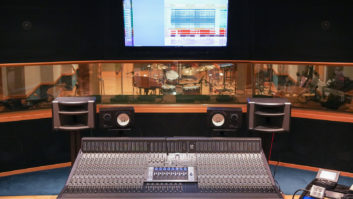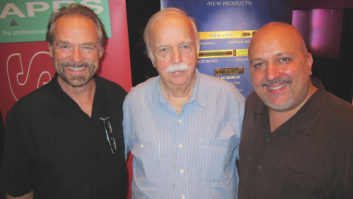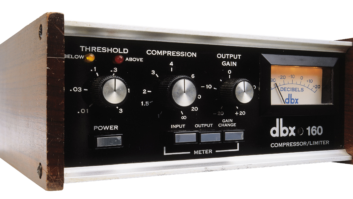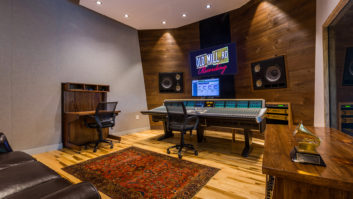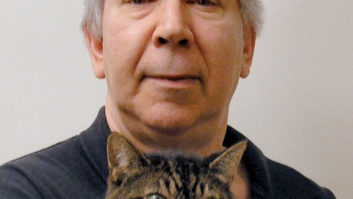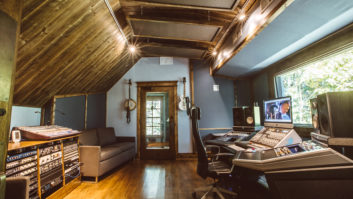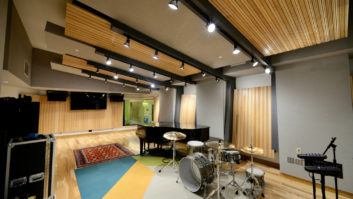19 of the Hottest New Rooms to Open This Year
On the Cover: Metropolitan Recording
Featured on this month’s cover is Metropolitan Recording of Bryn Mawr, Pa., the home for founder and CEO of RuffHouse/Columbia Records Chris Schwartz, who opened the space in late 2000 as a full-service production facility for both the label’s roster of acts, such as The Fugees, Cypress Hill, Lauryn Hill and Wyclef Jean, and “outside” clients. Designed by Martin Pilchner, of Pilchner Schoustal, who worked alongside in-house producer Ian Cross and builder Carl Schwartz of Schwartz Bros. Construction throughout the project, to re-use this turn-of-the-century carriage house, it incorporates the original vaulted ceilings and exposed trusses. The interior features a number of custom acoustical treatments that aid in maintaining a high degree of sound isolation and aesthetic appeal. The control room boasts numerous purpose-built modifications to yield better ergonomics and provide for a more accurate listening environment. Equipment of note includes a 72-input SSL J Series 9000 console, two Studer A-827 2-inch tape machines, Pro Tools 5.1 and an impressive array of contemporary and vintage outboard gear. Main monitors include Quested Q212s.
Sound on Sound Recording, Studio C
This New York City studio was redesigned by John Storyk with acoustical consulting by George Augspurger. The room features an AMS-Neve Capricorn digital console, Sony 3348 tape machine, Pro Tools 24 with Martinsound Multimax surround monitoring control; monitoring includes custom-Augspurger monitors with TAD components and five Genelec 1031A near-fields. The room was finished in September 2000.
Glenwood Place Studios
Chicago Recording Company owner Alan Kubicka’s new West Coast venture, this facility was renovated by VP Phil Bonnano and acoustician Carl Yanchar of Wave:Space Inc. in 2001. Located in Burbank, Calif., the studio features a 72-input Amek 9098i by Mr. Rupert Neve, Wave:Space custom monitors, Studer A827 Gold Edition analog 24-track machine and a complement of outboard gear from API, Lexicon, Manley and TC Electronic.
M-Works Mastering
Opened in March 2000, this 2,700-square-foot-facility, designed by George Augspurger, comprises three mastering suites, two of which focus on traditional mastering with a third room dedicated to 5.1 and DVD applications. Located in Cambridge, Mass., all three rooms master to Sonic Solutions. Studio A monitoring is handled by Dunleavy SC-5s, while Studio B uses Tannoy DMT-12s and Studio C a Genelec 5.1 system. Studio C also includes a Sony XBR 32-inch monitor for film sound work. Recent projects include Aerosmith, Aimee Mann and the Mighty Mighty Bosstones.
Chris Beck Music Studio
Santa Monica, Calif.-based Chris Beck Music Studio is the picture of modernity with three Yamaha 02R consoles interfacing with a MOTU 2408/Digital Performer hard disk system for this music composer’s own workspace. Designed by studio bau:ton in August 2000, the room enhances the natural light that streams in from the open spaces in the skylight, windows and glazed door. Monitoring is done through PMC MBI-P.
Bogart Recording Studios
This new studio in North Miami, Fla., opened in March 2000, was acoustically designed by Andy Munro of Munro Associates and Dave Malekpour of Pro Audio Design. The live room’s 16-foot ceilings, stone walls and hardwood floors welcome the likes of the Backstreet Boys, Mariah Carey, Gloria Estefan, KISS and Prince. The control room is based around a 56-input SSL 4000 G Series console and an Otari RADAR II 24-bit digital recorder. Monitoring is through Dynaudio C4A and M1 near-fields. The studio is also equipped with Alesis ML9600 Masterlink multitrack recorder and Apogee AD/DA converters, as well as a healthy array of outboard gear.
Studio Atlantis
Opened in August of 2000, the new studio bau:ton-designed Studio Atlantis (Hollywood) boasts a Trident 80B 56-input console with Uptown moving faders and Herzer mods for commercial recording. The aquatic-themed room features a Studer A-80 or Pro Tools recording and has a variety of monitoring options, which include UREI 813-B time-aligned monitors, modified by Vernon Systems, and Yamaha and Tannoy systems. Clients include The Temptations, Matt Sorum and Slash.
Secret Garden
Opened in October 2000 and designed by Chris Pelonis of Pelonis Sound and Acoustics, owner/artist/producer Ben Margulies and Mike Lee of Dreams and Designs, this Santa Barbara, Calif.-based studio features an Amek Einstein console, Otari 24-track recorder, Pro Tools Mix-plus, Tannoy 215 mkII and Mackie monitors. A full complement of outboard gear is represented by Avalon, Focusrite, TC Electronic, Eventide, Oram and Neve.
Cartee Day Studios
This 7.1-equipped, Nashville-based studio was built from the ground up by Michael Cronin Acoustic Construction and opened in February 2001. The 20×30-foot control room features an AMS-Neve VXS 72 console. The main monitors are Munro Associates DynAudio M4+, and near-fields include KRK E-8s and Yamaha NS-10Ms. The studio also features a Studer D-827 and an 827 Gold tape machine.
The Body
Carter Burwell’s personal studio (New York City) was designed by John Storyk and Scott Yates of Walters-Storyk Design Group in May 2000. Furnished with a Euphonix System 5 console and three-way Genelec 1037 5.1 monitoring, the studio also hosts such gear as Digital Performer, Pro Tools, Korg Wavestation, Yamaha TG77 and a Roland VP-9000 Variphrase processor. Burwell’s film composing credits include Three Kings, Being John Malkovich and Fargo.
5.1 Entertainment Group
Redesigned in April 2000 by the studio’s own audio team, this two-room facility hosts a Soundtracs DPC2 digital production console, M&K surround sound speakers, Pro Tools hard disk recording, Studer A827, and Tascam DA-88, 78, 98, as well as Apogee 24/96 converters. The main tracking rooms also have two Euphonix R-1 48-track tapeless recorders. Located in Los Angeles, the interior design was handled by Jane Brooks Interiors and Dianne Caillat.
Sonic Arts Digital Audio Services, Mix2Pix Suite
Opened in May 2000, this Russ Berger Design Group-designed studio was remodeled to fit seamlessly into the historic motif of downtown Cincinnati. The facility boasts two identical control rooms with a central machine room, Pro Tools MIX Plus, 16-channel Pro Control, Quested 5.1 surround monitoring and an extensive complement of mics for use in ADR and Foley. Most clients are working in film sound and use the studio’s high-resolution, large-screen video projection for mix-to-picture work.
Rainmaker
This Richmond, Va.-based multiroom facility employed the design of Recording Architecture of London Inc., to build the two control rooms, two studios, MIDI production suite and ancillary spaces, which opened in June 2000. The interior is augmented with a spattering of exposed brick and hickory floors. Tracking is down to Pro Tools MIX|24; the console is a Brent Averill Neve, equipped with API mic pre’s. Monitoring is through an ATC 5.1 system.
Artisan Recorders Mobile Studio
Back online in late-March 2000, this mobile unit (Ft. Lauderdale, Fla.) was redesigned by John Arthur Design Group to improve the overall aesthetics, acoustics and ergonomic functionality. Features of note include an Amek Hendrix console, Hafler monitors, analog and digital multitrack options, and a generous amount of outboard gear. The truck also features a client area, 5.1-capable mix environment, and isolated machine and tape op area.
SoundCastle Studio II
This January 2001 redesigned studio (Los Angeles) by Studio 440 houses a surround-capable SSL SL 4000 G+ classic console and custom Augspurger monitors with TAD and JBL components. Recording formats include Studer 827 and 820 24-track recorders and an 820 1/2-inch 2-track, Panasonic SV-3700 DAT and Sony DBU 950 3/4-inch video for sync-to-picture work. The room was originally designed by Augspurger with interior treatments handled by Waterland.
Sand Hills Studios
Catering to both Latin and U.S. artists, this new studio is located on a 40-acre ranch outside of Portales, N.M. Boasting a Neve VR60-FF console with automation, Studer analog, Pro Tools, ADAT recording and a healthy array of outboard gear, the studio also includes main monitors from TAD, Meyer and Yamaha. Designed by chief engineer Rob Russell and owner Rocky Garcia (of Mexican group Los Huracanes Del Norte), the studio opened its doors in March 2000.
Phase One Recording Studio B
This Pilchner Schoustal-redesigned room (Scarborough, Ontario) is centered around an automated API Legacy 64-input console. Recording is done to Studer 827, Pro Tools 24, ADAT, Tascam DA-98 and -38, and an Ampex ATR 100 tape machine. The interior redesign features natural maple floor and wall-paneling and perforated birch ceiling panels. The rear wall also features an RPG Diffusor array. The existing MEG monitor system was also physically and electronically upgraded for the September 2000 opening.
The Post Shop
This Toronto-based studio added two new audio suites in January 2001, a 5.1 room and a mastering suite, both designed by Pilchner Schoustal. The 5.1 room showcases a Pro Tools MIX Plus system on a Mac 500MHz G4 through Digidesign 888 I/O with Pro Control. Monitoring options include Genelec 1032 with a 1092 subwoofer and Auratone 5PSC monitors; in addition to a healthy choice of audio/video recording options, the room hosts a Sony Vega 32-inch XVR video monitor. The mastering suite is running Pro Tools MIX 24 with a Yamaha 03D digital mixing console, while monitoring is done through Genelec 1038s. Mastering formats include Panasonic DAT recorders and an Otari MPR-12 1/4-inch recorder. For Foley work, the room is also equipped with a 42-inch Sony plasma PFM-510 A1WU video monitor.
Masterdisk
Located in New York City, this stereo mastering suite for senior mastering engineer Tony Dawsey was redesigned by Francis Manzella in April 2000. The room was designed around a modified reflection-free zone to enhance the room’s imaging. The suite also features a custom analog mastering console, Sony Digital Editor, converters by Prism, DCS, Apogee and Studer, and Griffin mastering loudspeakers.
